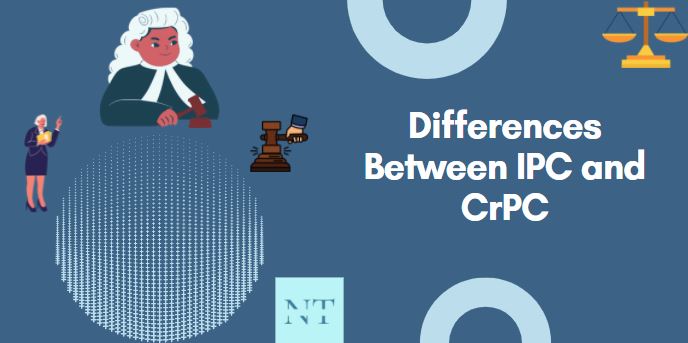Differences Between IPC and CrPC: Because illegal acts are regarded crimes in rem, or crimes against society as a whole, the State is the prosecuting party in courts. The Concurrent List deals with criminal law and criminal process, whereas the State List deals with police and prisons. The Indian Penal Code (IPC) and the Criminal Procedure Code (CrPC) are the statutes that regulate criminal law in India. In the event that a crime has been committed, the IPC specifies the substantive law to be applied. The CrPC outlines the processes to be followed by the law enforcement agencies throughout an investigation and trial.
Table of Contents
Indian Penal Code, 1860
The Code, which was drafted during the British Raj in 1850 and handed to the Indian Legislative Council in 1856, is the country’s fundamental criminal code. It went into effect on January 1, 1862.
The Code includes a wide range of offences (split into many categories) as well as the associated penalties. For example, crimes against the person (murder, abduction, culpable homicide, and so on), crimes against property (stealing, dacoity, and so on), economic offences (cheating and forgery), and a variety of others.
The Criminal Procedure Code, 1973
The Code is a procedural legislation that lays out a step-by-step mechanism for enforcing criminal laws. As a result, it is responsible for enforcing and administering the Indian Penal Code as well as other substantive criminal legislation. The Code was created by Parliament on January 25, 1974, to streamline and modernise the law governing criminal procedure.
Together with the Indian Penal Code of 1862 and the Indian Evidence Act of 1872, the Criminal Procedure Code is read. The distinction between the Indian Penal Code of 1862 and the Criminal Procedure Code of 1973 is frequently misunderstood.
Comparison and Differences Between IPC And CrPC
Scope of IPC: The code is organised into twenty-three chapters, each of which contains 511 sections that address a variety of offences, penalties, punishments, and exclusions. The punishments are grouped into five categories in this code: death, imprisonment for life, general confinement, confiscation of property, and penalty. The law would apply to anyone of Indian origin, with the exception of members of the Indian army, who are not subject to the IPC.

Scope of CrPC: Criminal Procedure Code targets giving the authentic instrument to the bother of criminal law in the country, by setting up the significant equipment for catching hooligans, investigating cases, presenting offenders under the careful attention of the courts, gathering proof, choosing the obligation or guiltlessness of reprimanded, constraining disciplines or teaches, on the accused. Along these lines, it depicts the entire procedure for assessment, fundamental, bail, interrogation, catch, and so forth
Further, it sets out the classes of criminal courts, for instance high courts, courts of meeting, legitimate appointed authority of the first in class, lawful official of the second class, boss equity wherein different sorts of offences are brought for fundamentals. Other than these courts, high courts have an authoritative power. Additionally, there is a requirement of sentences which these courts can pass.
Procedural and Substantive Differences Between CrPC and IPC
IPC: A substantive law is the Indian Penal Code. Substantive law is a body of law that outlines civil law rights and obligations, as well as criminal law offences and penalties. As a result, the Indian Penal Code is the legislation that specifies the crimes that are punished, as well as their punishments or penalties, or even both. It describes all conceivable offences as well as the consequences that go along with them.
CrPC: The Code of Criminal Procedure, on the other hand, is a procedural statute. Procedural law is a system of law that establishes the mechanisms for enforcing substantive law. As a result, the Criminal Procedure Code seems to be the statute that lays out the general procedure that the courts must follow in a criminal case.
Other Points of Difference
The Indian Penal Code lists a variety of offences and divides them into several categories. The fines and punishments for the various offences are also specified in the Code. The Criminal Procedure Code, on the other hand, specifies the steps that the police must follow once they have committed any of the crimes listed in the criminal code.
The Indian Penal Code is intended to serve as the country’s principal penal code for punishing lawbreakers. The major purpose of the Criminal Procedure Code, on the other part, is to establish binding procedures which must be followed during the conduct of a criminal case.
The courts and magistrates’ powers are provided for in the Criminal Procedure Code of 1973, but not in the Indian Penal Code.
Example
A individual named “X” intended to kill some other person named “Y,” so he broke into his house and murdered him by slicing his throat with a hammer. Murder is defined under Section 300 of the Indian Penal Code of 1860. And Section 302 of the Code specifies the penalty for the offence. Anyone who performs the conduct will be sentenced to death or life in prison, according to the provision.
What kind of punishment will X receive for the offence he committed?
Murder is a cognizable and non-bailable crime. The Criminal Method Code of 1973 establishes a procedure for determining the offender’s guilt, if or not bail would be allowed, the evidence that will be considered, the trial, the inquiry, and the imposition of the individual sentence.
Conclusion
The three main pieces of legislation regulating criminal law in India are the Indian Penal Code, the Code of Criminal Procedure, and the Indian Evidence Act. They tend to play a significant part in the proper enforcement of the law and justice in the courtroom. There is also further law that supplements the three major pieces of legislation, including the Prohibition of Child Trafficking Act and the Juvenile Justice Act. Both IPC and the CrPC are pan-India statutes that cover the whole country. They have no authority over Jammu & Kashmir. The IPC seems to be the sole substantive law in this situation, whereas the CrPC seems to be the procedural law.
REFERENCES
- Commentaries on Code of Criminal Procedure, 1973 (Allahabad: Law Publishers India, 2009.
- Criminal Procedure Code 1973 Vol. 2 (India: LexisNexis Butterworths Wadhwa Nagpur, 2010).
- Ratanlal Ranchhoddas, Ratanlal & Dhirajlal’s the Indian Penal Code (Act XLV of 1860), 3rd ed. (New Delhi: Wadhwa & Co., 2007).
- Gaur, K. D. A Textbook on the Indian Penal Code. Oxford & IBH Publishing Co. Pvt. Ltd., 1998.
Suggested Reading:
| Go To Sundarban News Today’s Home Page | Click Here |
| Wikipedia Article on CrPC | Click Here |
| Wikipedia Article on IPC | Click Here |
| Article Category | Legal Guide |
